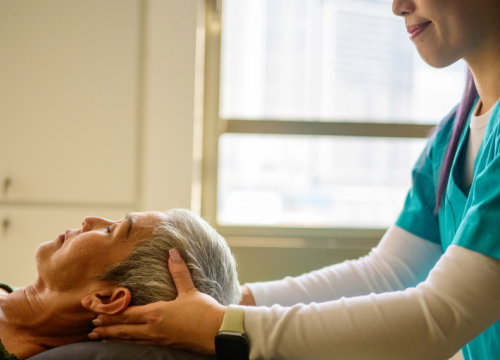8 Questions You’ve Always Wanted to Ask an Occupational Therapist
Occupational therapists help people with Parkinson’s disease (PD) remain independent and pursuing the activities they enjoy. Heather Simpson, OTD, OTR/L is an occupational therapist at the Norman Fixel Institute for Neurological Diseases at the University of Florida. At the Fixel Institute, she treats people with Parkinson's and other movement disorders while serving as co-clinical coordinator for their Parkinson’s Foundation Center of Excellence. In this article, Heather answers the most frequently asked questions about Parkinson’s and occupational therapy (OT).
What is your definition of occupational therapy?
Occupational therapy is a form of rehab therapy in which therapists use everyday activities to promote health, wellbeing and your ability to participate in meaningful activities in your life. OT works on “occupations,” which include self-care activities (like dressing, eating, bathing and toileting), home management activities (like cooking and driving) and leisure activities. Occupational therapy is individualized, but our goal is to make each person feel comfortable with who they are and help them live independently for as long as possible.
When should a person with PD start occupational therapy?
Research supports that occupational therapy intervention, along with physical therapy and speech therapy, can be very helpful for people with Parkinson’s disease. Starting occupational therapy early on is highly recommended. Even if you are independent when you first get diagnosed with Parkinson’s, starting OT can provide you with a home program that reacts to existing PD symptoms and prevents additional PD symptoms from occurring. OT can also give you tips and strategies to make sure you're feeling your best during daily activities.
What are the benefits of occupational therapy for people with Parkinson’s?
What I love about OT is that it's holistic. We provide evidence-based interventions to help people enjoy life through everyday activities. OT is also tailored to your individual needs as a person with Parkinson’s. For movement symptoms, we can help with posture, rigidity, bradykinesia and fine motor skills. For non-movement skills, we work on improving sleep, vision, cognition and mood. Occupational therapy is useful because it’s available in many different settings — it can be found in outpatient therapy, inpatient therapy, hospitals, nursing homes and more.
Is it better to go to a specialized facility for occupational therapy?
Getting occupational therapy services is important no matter what, but therapists at Parkinson’s Foundation Centers of Excellence are specialized in Parkinson's and related disorders. They do a lot of research and learning, particularly about Parkinson's, and can work together with your local providers to give PD-specific recommendations.
Occupational therapists at specialized facilities also work directly with the physicians on your multidisciplinary team. This type of collaboration can help make sure that we're understanding your symptoms and your needs.
How does an occupational therapist collaborate with the Parkinson’s care team?
Occupational therapists are an important part of the care team for people living with Parkinson’s. We are directly involved with physicians and nurses, as well as physical therapists and speech-language pathologists. Since occupational therapists may work with you more regularly than you see your neurologist, we can be the eyes and the ears for other members of the team.
For example, if you come into an OT session and we notice you are experiencing new movement fluctuations, we can reach out to your doctor on your behalf to address the issue. Occupational therapists coordinate closely with your doctor and help make critical decisions for your care.
Can you share an inspirational story about one of your PD clients?
Occupational therapy is meaningful because it is person-centered and works to meet an individual’s needs. One of my clients was highly motivated by her role as a mother and a grandmother. She had a hard time moving her arms, hands and fingers, but through OT we found ways to adapt board games so she could play with her grandkids when they came to visit. Even though she had limited physical ability, we were able to maintain what she found important in her daily activities through these personalized interventions.
How do you manage the stress that can accompany helping other people?
I love what I do for work, but I think it’s also very important to maintain the other roles I play in my life: friend, sister, daughter and spouse. I take time to pursue activities outside of work that fulfill those roles. I exercise, go to therapy and plan specialized date nights with my friends.
People in the Parkinson’s community may have a similar experience when it comes to the roles they play in life. When someone is diagnosed with PD, they may feel like they have to exercise full-time. Care partners may feel like they need to be a care partner at all times, and they lose their role as a spouse. I think it’s important to find a balance between your various roles whenever possible.
What is a takeaway the PD community should know about occupational therapy?
Occupational therapy is an individualized therapy that ensures safety, independence and happiness. It allows you to maintain your sense of self. OT is critical throughout all stages of Parkinson’s, from diagnosis to palliative care, but it is designed to help you maintain a sense of self and be happy with who you are.
For help finding an occupational therapist near you, contact our Helpline at 1-800-4PD-INFO (1-800-473-4636).
Related Blog Posts


Celebrating 12 Milestones that Defined 2025

